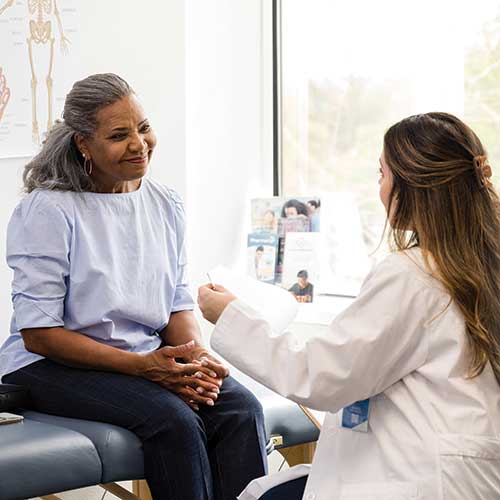October 2024
Menopause was once a taboo subject, talked about in hushed tones, if at all. Many women didn’t fully understand it or didn’t get the help they needed for their challenging symptoms. Today, talking about menopause is no longer taboo — and it’s crucial to women’s health as they age. If you’re a woman, here’s what you should know about menopause.
What Is Menopause?
According to the National Institute on Aging, true menopause occurs 12 months after your last menstrual period. Most women start the menopausal transition — called perimenopause — between the ages of 45 and 55.
Once perimenopause begins, it takes seven years on average before menopause happens. During perimenopause, you may have irregular periods, including lighter or heavier bleeding, shorter duration between periods, or spotting.
Hormonal and other body changes during perimenopause and after can also cause a range of bothersome symptoms, including anxiety and depression; mood and memory changes; hot flashes; night sweats; sleep problems; sexual problems; bladder problems; hair loss; and vaginal dryness.
You can experience many of these symptoms for up to 10 years after menopause. If you experience bleeding or spotting after menopause, let your doctor know. It may point to something benign, such as an infection, or, in rare cases, ovarian or gynecological cancer.
Treatment for Menopausal Symptoms
You don’t have to grin and bear your menopausal symptoms. The first step to getting help is talking to your doctor or gynecologist. They can prescribe treatment options that can help reduce bothersome symptoms. The Office on Women’s Health lists these as treatments:
Low-dose hormonal birth control. This may help reduce or stop hot flashes, vaginal dryness, and mood swings in the years before menopause. It can also help control heavy or irregular periods.
Menopausal hormone therapy. This FDA-approved treatment is for managing postmenopausal symptoms. Menopausal hormone therapy is available as either estrogen replacement therapy or hormone replacement therapy, which includes both estrogen and progestin, a synthetic form of progesterone.
You can safely take estrogen by itself if you don’t have a uterus. If you have a uterus, taking estrogen alone can increase your risk of endometrial cancer. Adding progestin reduces that risk.
Menopausal hormone therapy can increase your risk for blood clots, stroke, and some cancers. That’s why FDA guidelines recommend using it at the lowest effective dose for the shortest time possible to manage your symptoms.
Ospemifene. This medication is FDA-approved to treat painful sex caused by menopause. While this is another nonhormonal option, it acts like estrogen in your body. So, if you have a uterus, you need to take progestin with it. You should also take this at the lowest effective dose for the shortest amount of time needed to manage your symptoms.
Paroxetine. This FDA-approved treatment is a nonhormonal option that is used to treat moderate to severe hot flashes and night sweats. It’s a low-dose selective serotonin reuptake inhibitor (SSRI) — a kind of medication used to treat depression.
Prasterone. This FDA-approved topical hormonal medicine is used to treat painful sex caused by vaginal dryness after menopause. The medicine is applied in the vagina once a day.
Over-the-counter (OTC) products. These can include products, such as vaginal lubricants or moisturizers, to make sex more comfortable.
Mental health care. If you have mental health concerns, your doctor can refer you to a mental health professional who can help. Treatment for mental health issues often includes a combination of psychotherapy and medication, including antidepressants.
Online assistance. My Menoplan at mymenoplan.org is a free online tool developed by researchers funded by the National Institute on Aging. It can help you narrow your search for treatments and coping strategies based on your menopause symptoms.
Even if you don’t have bothersome symptoms, talking about menopause with your doctor can help safeguard your health. Your doctor can help guide you on how to protect your bone, heart, and physical health during the menopausal transition and beyond.



